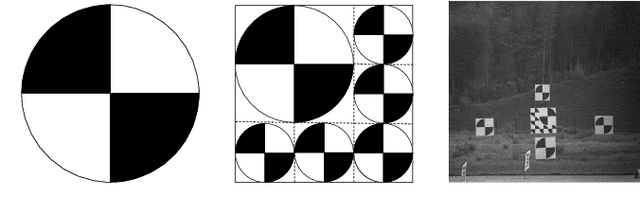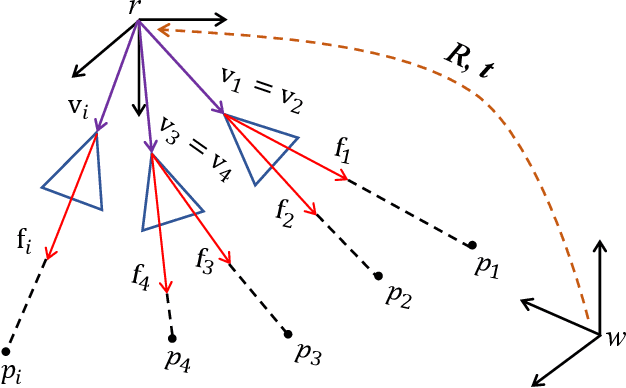Yang Shang
Learning Affine Correspondences by Integrating Geometric Constraints
Apr 10, 2025Abstract:Affine correspondences have received significant attention due to their benefits in tasks like image matching and pose estimation. Existing methods for extracting affine correspondences still have many limitations in terms of performance; thus, exploring a new paradigm is crucial. In this paper, we present a new pipeline designed for extracting accurate affine correspondences by integrating dense matching and geometric constraints. Specifically, a novel extraction framework is introduced, with the aid of dense matching and a novel keypoint scale and orientation estimator. For this purpose, we propose loss functions based on geometric constraints, which can effectively improve accuracy by supervising neural networks to learn feature geometry. The experimental show that the accuracy and robustness of our method outperform the existing ones in image matching tasks. To further demonstrate the effectiveness of the proposed method, we applied it to relative pose estimation. Affine correspondences extracted by our method lead to more accurate poses than the baselines on a range of real-world datasets. The code is available at https://github.com/stilcrad/DenseAffine.
Stereo Event-based, 6-DOF Pose Tracking for Uncooperative Spacecraft
Mar 17, 2025Abstract:Pose tracking of uncooperative spacecraft is an essential technology for space exploration and on-orbit servicing, which remains an open problem. Event cameras possess numerous advantages, such as high dynamic range, high temporal resolution, and low power consumption. These attributes hold the promise of overcoming challenges encountered by conventional cameras, including motion blur and extreme illumination, among others. To address the standard on-orbit observation missions, we propose a line-based pose tracking method for uncooperative spacecraft utilizing a stereo event camera. To begin with, we estimate the wireframe model of uncooperative spacecraft, leveraging the spatio-temporal consistency of stereo event streams for line-based reconstruction. Then, we develop an effective strategy to establish correspondences between events and projected lines of uncooperative spacecraft. Using these correspondences, we formulate the pose tracking as a continuous optimization process over 6-DOF motion parameters, achieved by minimizing event-line distances. Moreover, we construct a stereo event-based uncooperative spacecraft motion dataset, encompassing both simulated and real events. The proposed method is quantitatively evaluated through experiments conducted on our self-collected dataset, demonstrating an improvement in terms of effectiveness and accuracy over competing methods. The code will be open-sourced at https://github.com/Zibin6/SE6PT.
Building 3D In-Context Learning Universal Model in Neuroimaging
Mar 04, 2025Abstract:In-context learning (ICL), a type of universal model, demonstrates exceptional generalization across a wide range of tasks without retraining by leveraging task-specific guidance from context, making it particularly effective for the complex demands of neuroimaging. However, existing ICL models, which take 2D images as input, struggle to fully leverage the 3D anatomical structures in neuroimages, leading to a lack of global awareness and suboptimal performance. In this regard, we introduce Neuroverse3D, an ICL model capable of performing multiple neuroimaging tasks (e.g., segmentation, denoising, inpainting) in 3D. Neuroverse3D overcomes the large memory consumption due to 3D inputs through adaptive parallel-sequential context processing and a U-shape fusion strategy, allowing it to handle an unlimited number of context images. Additionally, we propose an optimized loss to balance multi-task training and enhance the focus on anatomical structures. Our study incorporates 43,674 3D scans from 19 neuroimaging datasets and evaluates Neuroverse3D on 14 diverse tasks using held-out test sets. The results demonstrate that Neuroverse3D significantly outperforms existing ICL models and closely matches the performance of task-specific models. The code and model weights are publicly released at: https://github.com/jiesihu/Neu3D.
Accurate Pose Estimation for Flight Platforms based on Divergent Multi-Aperture Imaging System
Feb 27, 2025



Abstract:Vision-based pose estimation plays a crucial role in the autonomous navigation of flight platforms. However, the field of view and spatial resolution of the camera limit pose estimation accuracy. This paper designs a divergent multi-aperture imaging system (DMAIS), equivalent to a single imaging system to achieve simultaneous observation of a large field of view and high spatial resolution. The DMAIS overcomes traditional observation limitations, allowing accurate pose estimation for the flight platform. {Before conducting pose estimation, the DMAIS must be calibrated. To this end we propose a calibration method for DMAIS based on the 3D calibration field.} The calibration process determines the imaging parameters of the DMAIS, which allows us to model DMAIS as a generalized camera. Subsequently, a new algorithm for accurately determining the pose of flight platform is introduced. We transform the absolute pose estimation problem into a nonlinear minimization problem. New optimality conditions are established for solving this problem based on Lagrange multipliers. Finally, real calibration experiments show the effectiveness and accuracy of the proposed method. Results from real flight experiments validate the system's ability to achieve centimeter-level positioning accuracy and arc-minute-level orientation accuracy.
3D Trajectory Reconstruction of Moving Points Based on a Monocular Camera
Feb 27, 2025



Abstract:The motion measurement of point targets constitutes a fundamental problem in photogrammetry, with extensive applications across various engineering domains. Reconstructing a point's 3D motion just from the images captured by only a monocular camera is unfeasible without prior assumptions. Under limited observation conditions such as insufficient observations, long distance, and high observation error of platform, the least squares estimation faces the issue of ill-conditioning. This paper presents an algorithm for reconstructing 3D trajectories of moving points using a monocular camera. The motion of the points is represented through temporal polynomials. Ridge estimation is introduced to mitigate the issues of ill-conditioning caused by limited observation conditions. Then, an automatic algorithm for determining the order of the temporal polynomials is proposed. Furthermore, the definition of reconstructability for temporal polynomials is proposed to describe the reconstruction accuracy quantitatively. The simulated and real-world experimental results demonstrate the feasibility, accuracy, and efficiency of the proposed method.
High-precision visual navigation device calibration method based on collimator
Feb 25, 2025Abstract:Visual navigation devices require precise calibration to achieve high-precision localization and navigation, which includes camera and attitude calibration. To address the limitations of time-consuming camera calibration and complex attitude adjustment processes, this study presents a collimator-based calibration method and system. Based on the optical characteristics of the collimator, a single-image camera calibration algorithm is introduced. In addition, integrated with the precision adjustment mechanism of the calibration frame, a rotation transfer model between coordinate systems enables efficient attitude calibration. Experimental results demonstrate that the proposed method achieves accuracy and stability comparable to traditional multi-image calibration techniques. Specifically, the re-projection errors are less than 0.1463 pixels, and average attitude angle errors are less than 0.0586 degrees with a standard deviation less than 0.0257 degrees, demonstrating high precision and robustness.
Camera Calibration using a Collimator System
Sep 30, 2024



Abstract:Camera calibration is a crucial step in photogrammetry and 3D vision applications. In practical scenarios with a long working distance to cover a wide area, target-based calibration methods become complicated and inflexible due to site limitations. This paper introduces a novel camera calibration method using a collimator system, which can provide a reliable and controllable calibration environment for cameras with varying working distances. Based on the optical geometry of the collimator system, we prove that the relative motion between the target and camera conforms to the spherical motion model, reducing the original 6DOF relative motion to 3DOF pure rotation motion. Furthermore, a closed-form solver for multiple views and a minimal solver for two views are proposed for camera calibration. The performance of our method is evaluated in both synthetic and real-world experiments, which verify the feasibility of calibration using the collimator system and demonstrate that our method is superior to the state-of-the-art methods. Demo code is available at https://github.com/LiangSK98/CollimatorCalibration.
Line-based 6-DoF Object Pose Estimation and Tracking With an Event Camera
Aug 06, 2024Abstract:Pose estimation and tracking of objects is a fundamental application in 3D vision. Event cameras possess remarkable attributes such as high dynamic range, low latency, and resilience against motion blur, which enables them to address challenging high dynamic range scenes or high-speed motion. These features make event cameras an ideal complement over standard cameras for object pose estimation. In this work, we propose a line-based robust pose estimation and tracking method for planar or non-planar objects using an event camera. Firstly, we extract object lines directly from events, then provide an initial pose using a globally-optimal Branch-and-Bound approach, where 2D-3D line correspondences are not known in advance. Subsequently, we utilize event-line matching to establish correspondences between 2D events and 3D models. Furthermore, object poses are refined and continuously tracked by minimizing event-line distances. Events are assigned different weights based on these distances, employing robust estimation algorithms. To evaluate the precision of the proposed methods in object pose estimation and tracking, we have devised and established an event-based moving object dataset. Compared against state-of-the-art methods, the robustness and accuracy of our methods have been validated both on synthetic experiments and the proposed dataset. The source code is available at https://github.com/Zibin6/LOPET.
 Add to Chrome
Add to Chrome Add to Firefox
Add to Firefox Add to Edge
Add to Edge